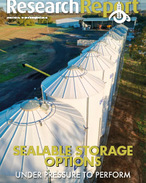This article is 3 years old. Images might not display.
The investment will see the Grains Research and Development Corporation (GRDC) and Cotton Research and Development Corporation (CRDC), in partnership with Goanna Ag develop a spray drift hazardous weather warning system that will provide real-time weather data and alerts to growers and spray operators about the presence of temperature inversions.
Goanna Ag will establish, operate and maintain a network of 100 Profiling Automatic Weather Stations (PAWS) across the grain and cotton regions of New South Wales, and southern and central Queensland. The PAWS have remote sensing capability and new proprietary software to provide growers and spray contractors real-time weather data every 10 minutes.
Being able to accurately identify the presence of hazardous temperature inversions will reduce the spray drift risk for growers and spray contractors. Currently regulations do not permit spraying agricultural chemicals when hazardous surface temperature inversions are present.
The network will provide a 24-hour forecast, broken into two hourly segments, of hazardous temperature inversions periods, significantly help growers and spray contractors to plan the logistics of spray operations.
The PAWS warning system builds on breakthrough research, conducted and published by Drs Graeme Tepper and Warwick Grace with support from GRDC and CRDC, and will be operational in time for the 2022-23 summer cropping season.
GRDC chair, John Woods, said the warning system would improve on-farm decision making by accurately identifying and forecasting hazardous spray conditions.
"Until recently, there has been no reliable and accurate method to determine when inversion conditions are hazardous for agricultural spraying using real time data," Mr Woods said.
CRDC's executive director, Dr Ian Taylor, said the partnership with Goanna Ag builds on six years of collaborative research and development from the RDCs.
"As research leaders, our organisations are committed to investing in research that supports improved on-farm practices and the sustainability of agriculture. Spray drift is a significant issue for agriculture and the wider community, and reducing its potential and impact is critical," he said.
For more information, visit https://bit.ly/3whujsS























